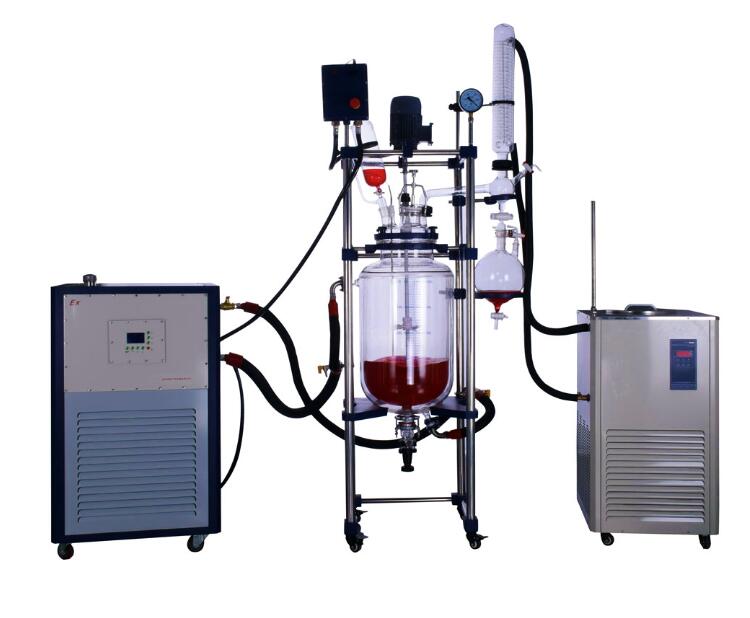Chemical reactors are considered as the heart of all chemical processes. A chemical reactor vessel is an enclosed volume that allows a chemical reaction to take place. It has a design that deals with many aspects of chemical engineering including evaporation, mixing, heating as well as cooling of the condensate. With a chemical glass reactor, you can control conditions such as pressure and temperature to create an ideal environment for a chemical reaction.
Chemical engineers design chemical reactors in a way that will maximize the net present value of a given reaction. They make sure that the reaction proceeds with the maximum efficiency toward the desired product giving the highest yields and, at the same time requiring the least sum of money to buy and operate.
What Are the Designs of Chemical Glass Reactor?

The design of a chemical glass reactor includes a mechanism that will regulate the pressure and temperature. The chemical components are subjected to a given condition to ensure proper working of the components that are involved in the particular chemical reaction. Some of the design considerations are:
– Controls.
The reactants are enclosed in a vessel which houses the chemical reagents. The reagents are subjected to different optimal conditions that guarantee the best chemical reactions. For instance, the chemists can provide activators, including enzymes that will accelerate the rate of the reaction.
– Discharge Valves.
They are included in the part of the controls. When the reagents pass through the different reaction conditions, they increase in volume. This increased volume has to be controlled through the discharge valves. Safety measures should be incorporated when using discharge valves to prevent accidents.
– Temperature Regulation.
For a chemical reaction to proceed fast, then you have to consider temperature control. A chemical reactor design has to incorporate this mechanism. A great advantage is that modern chemical reactors have automated systems that ensure the process of temperature regulation is fast and easy.
Different Chemical Reactor Types
Below are the different designs of chemical reactors.

1. Batch Reactor.
This is the simplest type of batch reactor where the materials are filled into the batch reactor then the reaction progresses with time. The reaction in a batch reactor does not reach a steady-state hence the control of pressure and temperature is crucial. Due to this factor, batch reactors have ports for sensors as well as material input and output.
Batch reactors are used in small scale production as well as reaction with biological materials such as the production of enzymes. Batch reactors are also used by scientists to carry out controlled processes in a small environment, and then it can be decided whether to be deployed on large scale production.
2. Continuous Stirred-Tank Reactor.
In CSTR, the reactions take place in several channels, and one or more reagents are loaded into a tank reactor that is stirred using an impeller to guarantee the proper mixing of the reagents. When the volume of the tank is divided by the average volumetric flow rate to the tank, then you get the time that is required to process one volume of fluid. Furthermore, if you use the chemical kinetics, then you can calculate the reaction’s expected percentage completion.
There are important aspects that need to be considered when using CSTR.
- At steady state, the inlet mass flow rate should be equal to the outlet flow rate to prevent the tank from overflowing or going empty.
- The reaction proceeds with the rate of reaction that is associated with the final output since the assumption is that the concentration is homogenous throughout the reaction.
- It is economical to operate several CSTRs in series since it enables the first CSTR to function at a higher reagent concentration, thus a higher reaction rate.
3. Plug Flow Reactor.
In the PFR reactor, one or more reagents are pumped through a tube, and the chemical reaction progresses as the reagents travel through the plug flow reactor. In this kind of reactor, the reaction rates create a gradient according to the distance traversed. At the inlet, the concentration of the reagents is high, but as the concentration of the product increases and the concentration of the reagents decreases, the reaction slows down.
There are several aspects that you need to know when it comes to PFR:
- The reagents can be introduced into the plug flow reactor at other positions other than the inlet. This can guarantee a higher efficiency as well as reducing the cost of PFR.
- The PFR design assumes that there is no axial mixing; thus, any element of the fluid that is traveling through the reactor will not mix with the fluid downstream or upstream, thus the term “plug flow.”
- Plug flow reactor has a greater efficiency compared to a continuous stirred tank reactor of the same volume.

